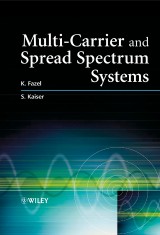Details

Multi-Carrier and Spread Spectrum Systems
1. Aufl.
|
97,99 € |
|
| Verlag: | Wiley |
| Format: | |
| Veröffentl.: | 06.02.2004 |
| ISBN/EAN: | 9780470871379 |
| Sprache: | englisch |
| Anzahl Seiten: | 298 |
DRM-geschütztes eBook, Sie benötigen z.B. Adobe Digital Editions und eine Adobe ID zum Lesen.
Beschreibungen
Frequency spectrum is a limited and valuable resource for wireless communications. A good example can be observed among network operators in Europe for the prices to pay for UMTS-frequency bands. Therefore, the first goal when designing future wireless communication systems (e.g. 4G - fourth generation) has to be the increase in spectral efficiency. The development in digital communications in the past years has enabled efficient modulation and coding techniques for robust and spectral efficient data, speech, audio and video transmission. These are the multi-carrier modulation (e.g. OFDM) and the spread spectrum technique (e.g. DS-CDMA), where OFDM was chosen for broadcast applications (DVB, DAB) as well as for broadband wireless indoor standards (ETSI HIPERLAN-II, IEEE-802.11) and the DS-CDMA was selected in mobile communications (IS-95, third generation mobile radio systems world wide, UMTS/IMT 2000).<br /> Since 1993 various combinations of multi-carrier (MC) modulation and the spread spectrum (SS) technique have been introduced and the field of MC-SS communications has become an independent and important research topic with increasing activities. New application fields have been proposed such as high rate cellular mobile, high rate wireless indoor and LMDS. It has been shown that MC-SS offers the high spectral efficiency, robustness and flexibility that is required for the next generation systems. Meanwhile, different alternative hybrid schemes such as OFDM/OFDMA, MC-TDMA, etc. have been deeply analysed and adopted in different international standards (ETSI-BRAN, IEEE-802 & MMAC).<br /> <br /> Multi-Carrier & Spread-Spectrum: Analysis of Hybrid Air Interfaces draws together all of the above mentioned hybrid schemes therefore providing a greatly needed resource for system engineers, telecommunication designers and researchers in order to enable them to develop, build and deploy several schemes based on MC-transmission for the next generation systems (which will be an integration of broadband multimedia services covering both 4G mobile and fixed wireless systems).<br /> * Offers a complete treatment of multi-carrier, spread-spectrum (SS) and time division multiplexing (TDM) techniques<br /> * Provides an in-depth insight into hybrid multiple access techniques based on multi-carrier (MC) transmission<br /> * Presents numerous hybrid multiple access and air interface architectures including OFDM/CDMA, MC-CDMA, MC-DS-CDMA and MT-CDMA<br /> * Covers new techniques such as space-time coding and software radio<br /> <br /> Telecommunications engineers, hardware & software system designers and researchers as well as students, lecturers and technicians will all find this an invaluable addition to their bookshelf.
Foreword. <p>Preface.</p> <p>Acknowledgements.</p> <p>Introduction.</p> <p>1. Fundamentals.</p> <p>Radio Channel Characteristics.</p> <p>Multi-Carrier Transmission.</p> <p>Spread Spectrum Techniques.</p> <p>Multi-Carrier Spread Spectrum.</p> <p>References.</p> <p>2. MC-CDMA and MC-DS-CDMA.</p> <p>MC-CDMA.</p> <p>MC-DS-CDMA.</p> <p>References.</p> <p>3. Hybrid Multiple Access Schemes.</p> <p>Introduction.</p> <p>Multi-Carrier FDMA.</p> <p>Multi-Carrier TDMA.</p> <p>Ultra Wide Band Systems.</p> <p>Comparison of Hybrid Multiple Access Schemes.</p> <p>References.</p> <p>4. Implementation Issues.</p> <p>Multi-Carrier Modulation and Demodulation.</p> <p>Synchronization.</p> <p>Channel Estimation.</p> <p>Channel Coding and Decoding.</p> <p>Signal Constellation, Mapping, Demapping, Equalization.</p> <p>Adaptive Techniques in Multi-Carrier Transmission.</p> <p>RF issues.</p> <p>References.</p> <p>5. Applications.</p> <p>Introduction.</p> <p>Cellular Mobile Communications Beyond 3G.</p> <p>Wireless Local Area Networks.</p> <p>Fixed Wireless Access below 10 GHz.</p> <p>Interaction Channel for DVB-T: DVB-RCT.</p> <p>References.</p> <p>6. Additional Techniques for Capacity and Flexibility Enhancement.</p> <p>Introduction.</p> <p>General Principle of Multiple Antenna Diversity.</p> <p>Diversity Techniques for Multi-Carrier Transmission</p> <p>Examples of Applications of Diversity Techniques.</p> <p>Software-Defined Radio.</p> <p>References.</p> <p>Definitions, Abbreviations and Symbols.</p> <p>Index.</p>
"This highly accessible work describes and analyzes the basic concepts of the combination of multcarrier transmission with spread spectrum (MC-SS)." (<i>IEEE Solid-State Circuits Society Newsletter</i>, January 2004)
Physicians, Biologists, Nurses, Athletic Trainers, Health Practicitioners, students and professors of anatomy and physiology
<i>Multi-Carrier and Spread Spectrum Systems</i> describes and analyses the basic concepts of the combination of multi-carrier transmission with spread spectrum (MC-SS). The various architectures and the different detection strategies are examined in some depth. Techniques for capacity and flexibility enhancement of multi-carrier systems such as diversity techniques and space-time/frequency coding (STC, STFC) are also analysed. <p>Since 1993 different multiple access concepts based on the MC-SS combination for mobile and wireless indoor communications called OFDM/CDMA or MC-CDMA and MC-DS-CDMA, have been proposed. The main differences between these schemes are in the spreading, frequency mapping, and detection strategies. Meanwhile, other alternative hybrid schemes such as OFDM/OFDMA, MC-TDMA, etc. have been deeply studied that benefit from the advantages of multi-carrier transmission.</p> <p>This book:</p> <ul> <li> <div>Covers multi-carrier and spread spectrum and all derivatives of spread spectrum and OFDM systems.</div> </li> <li> <div>Describes not only HIPERLAN but also wireless multi-user systems dealing with OFDM or spread spectrum techniques: 2G IS-95, 3G UMTS, and 4th Generation mobile communications.</div> </li> <li> <div>Provides significant analysis on multi-carrier transmission, from theory to practical implementations and is therefore invaluable for systems designers.</div> </li> <li> <div>Examines the essentials of all wireless standards based on multi-carrier/spread spectrum technique.</div> </li> </ul> <p>Written in a highly accessible manner this book will provide a unique reference on the topic of multi-carrier spread spectrum, assisting 4G engineers for their implementation.</p>


















